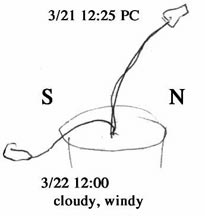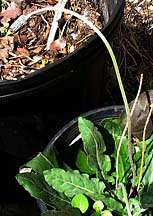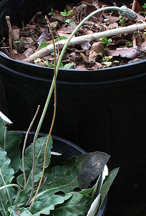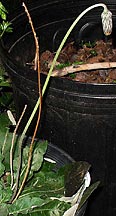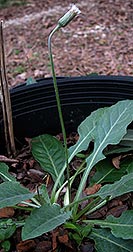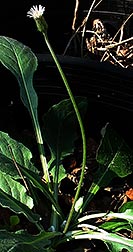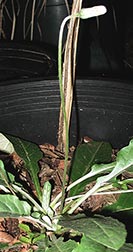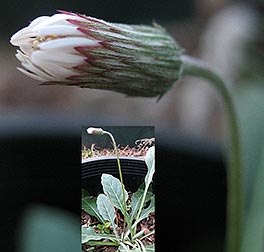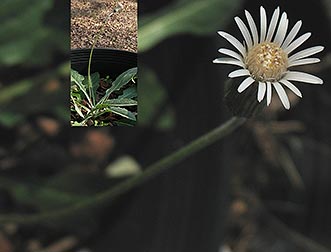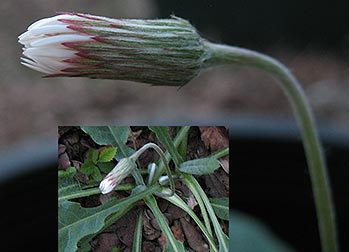Chaptalia carduacea & C. texana: Diurnal Nodding
by Bob Harms

Rising/Falling on day 5 in the bloom cycle of one C. carduacea head,
from 6:57 am to 7:27 pm on March 21, 2011.
(Place cursor on image for the time of day. Click for a larger image.)
Nodding behavior includes daily cycles during anthesis and day-to-day changes along the course from pre-anthesis to achene dispersal. During anthesis, the head begins the day in a lower position, rises by midday to a higher position, then falls to a lower position again by late afternoon. The amount of movement and the midday position vary by species, as summarized below for spring plants. (Detailed notes for two individual plants..)
Rising/Falling on days 4 (top row) & day 5 in the bloom cycle of one C. texana head, Feb. 17—18, 2011.
(Place cursor on image to see the species and date. Click for a larger image.)
Definitions:
- head alignment (angle of the head to the peduncle):
- erect: 0°
ascending: ± 45°
nutant: > 90° & < 150°
cernuous: facing the ground or ± 180°
C. carduacea (spring):
Anthesis: 4 days; dispersal at day 23.
The head remains closed and the ligules distally-directed (and hidden in the monitored specimen) during the entire bloom cycle. It is:
- nutant on day 1 of anthesis;
- erect at midday for very short period on days 2—3 of anthesis;
- ascending at midday on day 4 of anthesis;
- cernuous at midday during most of fruiting period (16 days);
- rising just prior to dispersal (day 23) and erect at dispersal (day 24).
Diurnal head alignment during anthesis undergoes a change of (30° —) 45° — 90° (— 115°) between midday position and early morning/evening position until day 9.
The heads are not heliotropic.
C. texana (spring):
Anthesis: 7 days; dispersal at day 28.
Days 3—7 of anthesis are marked by fully extended ligules, retroflexed together with the inner phyllaries and visually prominent. The head is:
- nutant on day 1 of anthesis (day 2 was not recorded);
- cernuous early on day 3 of anthesis, later in the day ascending;
- erect at midday on days 4—5 of anthesis, nearly erect (ca. 20°) on day 6;
- ascending on day 7;
- nutant at midday during most of fruiting period (17 days);
- rising to nearly erect (ca. 20°) at dispersal, day 28;
Diurnal head alignment during anthesis undergoes a change of 30°—45° (— 90°) between midday position and early morning/evening position until day 10.
The heads are heliotropic during early anthesis, but as the peduncle matures remain directed toward the strongest light source (i.e., do not change position at dark).
Although the C. carduacea plant monitored for spring nodding was from a population with reduced (not visible) ligules, field observation of a large population of plants with small, but visible ligules (largest noted for this species), indicated that there was no difference in the relatively short period of erect alignment. On any given day very few plants had erect heads. By contrast the population of C. texana had many plants with erect heads during the peak flowering period.
The nodding habit is not directly related to heliotropism, a property of C. texana (separate page for heliotropism).
Fall/Winter Phase Nodding
The nodding of C. texana heads without ligulate florets was noted in fall and winter, as the following series on September 28 shows (click for larger image):
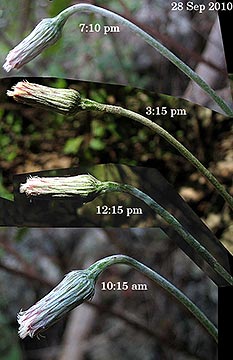
Corresponding observations of C. carduacea were not made for the fall/winter phase because at the time I was unaware of similar behavior of that species in spring phase.
Plant Resources Center Home Page — Flora of Texas
— Chaptalia


